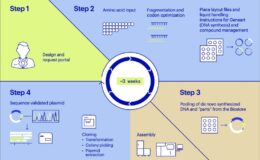A team of researchers from the Brigham Genomic Medicine program used a combination of gene sequencing and crowdsourcing to diagnose previously undiagnosed genetic diseases in 30 families who could not find the answer to their loved one’s condition. Here’s a look into their breakthroughs.
A needle in a haystack
 Konstantin Kolosov/Shutterstock
Konstantin Kolosov/Shutterstock
Uncovering medical mysteries takes work. “There are around 7,000 rare genetic diseases; of these, we know the genetic cause for half,” says Alireza Haghighi, MD, DPhil, the lead clinical molecular geneticist of Brigham Genomic Medicine (BGM), a program devoted to finding the genetic links to rare diseases. In fact, he says, the total number of rare genetic diseases may actually approach 15,000. For patients in the program, their families have exhausted available testing and gone through a cadre of specialists who couldn’t provide answers. Identifying a genetic cause is critical for patients, as it’s the first step in informing treatment or management, needed screening (for family members or prenatally), and can also help justify drug development, he says. For more info, check out the National Institutes of Health Undiagnosed Diseases Network.
The diagnosis: Thoracic aortic aneurysm and dissection
 RossHelen/Shutterstock
RossHelen/Shutterstock
When the upper part of the aorta (a major blood vessel) weakens, it can lead to a tear that causes life-threatening bleeding, explains the Mayo Clinic. The researchers identified a mutation—LOX—that can cause an aortic aneurysm. “If it’s carried in the same family, an aortic aneurysm usually goes undiagnosed until there’s a dissection or rupture—and many times it’s too late,” says Dr. Haghighi. In this family, all the members can now be tested for the gene to see if they have the mutation. If so, they’ll need regular screening for early detection. Here’s what to know if you’re taking an at-home genetic test.
The diagnosis: Congenital contractural arachnodactyly
 l i g h t p o e t/Shutterstock
l i g h t p o e t/Shutterstock
This disease, marked by long limbs, long, slender fingers and toes, and permanently bent joints that impact movement—was found to be “de novo.” Meaning, “it’s a new variant that arises in the person, but not present in either of the parents,” says Joel Krier, MD, clinical chief and faculty scientist in the Division of Genetics at Brigham and Women’s Hospital. Knowing this info alone gives families the reassurance that it likely won’t recur in future generations, something that can help them make the decision to have another child.
The diagnosis: Distal arthrogryposis type 5
 Tonhom1009/Shutterstock
Tonhom1009/Shutterstock
Two gene variants were discovered in two patients with this disease after one came to the hospital’s ER with problems breathing during flu season, the authors report in the study. Most people with this disorder have deeply set eyes, a dimpled chin, joint stiffness, and a “funnel chest,” where the breastbone is sunken in. Here’s how to know when joint stiffness is a serious problem.
The diagnosis: Lower extremity ischemia
 LightField Studios/Shutterstock
LightField Studios/Shutterstock
When a patient came to the ER with painful, dark, cold toes after developing a cold and specialists couldn’t pin down a cause, the patient was prescribed a “cocktail of drugs,” the researchers write in the study. After one clinician pointed out that other family members had a case of “painful blue toes,” after acquiring infections, they were able to find that a C3 gene mutation was responsible for the condition, which spanned generations. Find out some of the things your parents’ health reveals about you.
The diagnosis: Acrofrontofacionasal dysostosis syndrome
 l i g h t p o e t/Shutterstock
l i g h t p o e t/Shutterstock
The congenital syndrome leaves patients with an abnormal skull shape, a prominent forehead with a low hairline, cleft lip, small ears, and other facial and skeletal abnormalities, as well as severe intellectual disabilities. To say it’s extremely rare to find someone with this specific gene mutation is an understatement: Doctors have identified the disease in just 12 patients since it was first uncovered in 1985.
The diagnosis: Nemaline myopathy
 Flamingo Images/Shutterstock
Flamingo Images/Shutterstock
A patient with this disorder has severe muscle weakness, typically in the face, neck, and trunk, which gets worse with age and may advance such that they require a wheelchair. Those with nemaline myopathy have trouble eating and swallowing, and they may suffer from life-threatening breathing problems. The disease arises from a mutation in a gene that codes protein production within muscles; it occurs in 1 in 50,000 people.
The diagnosis: Progressive pseudorheumatoid arthropathy
 Dusan Petkovic/Shutterstock
Dusan Petkovic/Shutterstock
The disorder—marked by bowing legs, muscle weakness, and joint pain—appeared in childhood in this patient. It’s unlikely that doctors would diagnose the condition—the occurrence is one in one million. The study authors said it was understandable that cases like this are “misdiagnosed or undiagnosed simply because they are relatively rare and have not been previously seen by the referring clinical team.”
The diagnosis: Infantile inflammatory bowel disease
 Christopher Edwin Nuzzaco/Shutterstock
Christopher Edwin Nuzzaco/Shutterstock
In some cases, the research team that was working with the family prior didn’t have the tools available to make a diagnosis, like in this case of infantile-onset IBD, a very rare form of IBD. The genetic mutation that causes the more common form of IBD tends to be milder, explains Dr. Haghighi, and can be passed on. Here are some traits you thought were inherited, but aren’t.
The diagnosis: Congenital anomalies, polydactyly
 JoeZ/Shutterstock
JoeZ/Shutterstock
Investigators found that a variant on the MED12 gene is responsible for a patient with birth defects, polydactyly (additional fingers or toes), and developmental delays. This patient had a gene panel workup, but a variant identified was of “uncertain significance,” meaning, at the time, it was pinpointed as unusual, but clinicians didn’t know the role it played in the disease. In this case, it was the cause.
The diagnosis: Centronuclear myopathy
 bezikus/Shutterstock
bezikus/Shutterstock
Muscle weakness and wasting is the hallmark symptom of this disorder, which gets worse with age and can impair the ability to walk. This patient also had another genetic mutation that caused sensorineural hearing loss in both ears, a condition that’s the most common type of permanent hearing loss, according to the American Speech-Language-Hearing Association.
The diagnosis: Van Maldergem syndrome 1
 IvanRiver/Shutterstock
IvanRiver/Shutterstock
When members of a family have this disorder, they typically suffer from intellectual disabilities, hearing loss, facial or limb deformities, or issues with growth. Problems may first be detected during pregnancy or during infancy—however, it’s extremely rare, affecting less than one out of a million babies. Here’s one vitamin that helps protect against birth defects.
The diagnosis: Schaaf-Yang syndrome
 18percentgrey/Shutterstock
18percentgrey/Shutterstock
The MAGEL2 gene on chromosome 15 is responsible for this disorder, which is related to Prader-Willi syndrome (PWS). This case was “de novo,” which means it spontaneously occurred. “Often, knowing this helps parents come to peace with the medical condition that’s affecting one child,” says Dr. Krier. The syndrome causes low muscle tone, feeding problems, developmental and intellectual disabilities, and autism. Here are the things experts say everyone needs to know about autism.
The diagnosis: Frontonasal dysplasia-microphthalmia-facial clefting
 Monkey Business Images/Shutterstock
Monkey Business Images/Shutterstock
The ALX1 gene variant was responsible for a cluster of disorders, including frontonasal dysplasia (an abnormal development of the head and face before birth, such as wide-set eyes; at least 100 cases have been reported), microphthalmia (when one or both eyes are abnormally small, something that happens in 1 in 10,000 people), and facial clefting (a severe deformity of the face).
The diagnosis: Marshall-Smith syndrome
 Doucefleur/Shutterstock
Doucefleur/Shutterstock
This patient was discovered to have a mutation on their NFIX gene; symptoms of the syndrome include advanced bone age, bowed legs, failure to thrive, and intellectual disabilities. They also have breathing problems due to issues in the development of the jaw or airways. Like most cases of Marshall-Smith, this one was the first in the family. While there’s no cure, doctors can help manage symptoms. Learn the personal story of one woman who got her DNA tested—and how it changed everything for her.
The diagnosis: Angioedema type 3
 Maksym Poriechkin/shutterstock
Maksym Poriechkin/shutterstock
Researchers uncovered a mutation on the F12 gene, which code proteins that are involved in blood clotting. Therefore, the disorder appears as frequent episodes of swelling of certain body parts, like the face and intestinal tract, the latter of which can cause severe abdominal pain. As the name implies, there are three types; while angioedema affects one in 50,000 people, type 3 is extremely rare.
The diagnosis: Blepharocheilodontic syndrome
 UvGroup/Shutterstock
UvGroup/Shutterstock
Babies with BCD syndrome are born with a bilateral cleft lip and palate, eyelid abnormalities, and develop missing, misshapen teeth because of a mutation of the CDH1 gene. The gene controls proteins responsible for the development of cells that line the inside of the eyes and mouth. An incredibly rare disease, there are about 50 cases described in science. Find out more of the most shocking DNA test discoveries.














